-
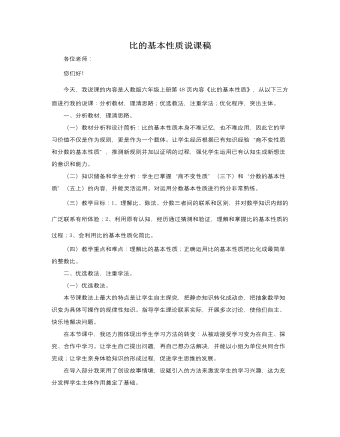
人教版新课标小学数学六年级上册比的基本性质说课稿
(二)注重学法。坚持“发展为本”,促进学生个性发展,并在时间和空间诸方面为学生提供发展的充分条件,以培养学生的实践能力、探索能力和创新精神为目标。在教学过程中,注意引导学生怎样有序观察、怎样概括结论,通过一系列活动,培养学生动手、动口、动脑的能力,使学生的观察能力、抽象概括能力逐步提高,教会学生学习。使学生通过自己的努力有所感受,有所感悟,有所发现,有所创新。小学生学习的数学应该是生活中的数学,是学生“自己的数学”。让学生在生活情境中“寻”数学,在实践操作中“做”数学,在现实生活中“用”数学。“学以致用”是学习的出发点和归宿点,也是学习数学的终结所在。让学生感到数学的有趣和可学,我们还应注重将数学知识提升应用到生活中,提高学生处理问题的实际能力,让学生真正做到会学习、会创造、会生活的一代新人,让数学课堂真正成为学生活动的、创造的课堂。三、优化程序,突出主体。
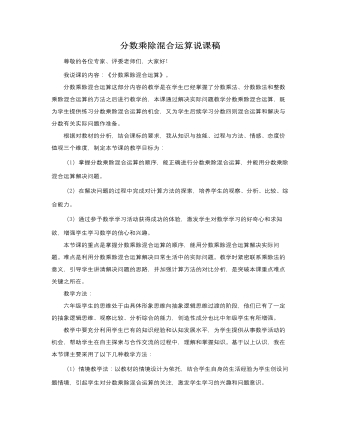
人教版新课标小学数学六年级上册分数乘除混合运算说课稿
仔细观察两位同学的算法,看看有什么不同之处?第一种是求解这道题的分步列式方法,第二种是列综合算式解答的算式。引导学生对比分步算式与综合算式,让学生体会乘除混合运算的顺序。组织学生讨论:分数乘除混合运算怎样计算?引导学生归纳:分数乘除混合运算中,遇到除以一个数时,只要乘以这个数的倒数,就可以把乘除混合运算转化为分数连乘,再按照分数连乘的方法进行计算。经过计算,你有什么经验要和同学们分享?想提醒大家注意什么?此处我尽量把解决问题的主动权交给学生,让他们进行讲解、讨论、对比、分析,再通过同伴间的互相交流,找到知识之间的内在联系。三、分层练习,巩固应用本课练习的设计以趣味性和层次性为原则,分别安排了“基础性练习”、“拓展性练习”和“趣味性练习”,检验学生的学习效果。1、基础性练习:做课本自主练习第3题,让学生自主完成,全班交流算法,目的是巩固算法,反馈学习效果。
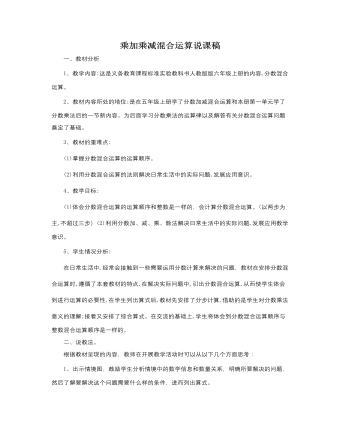
人教版新课标小学数学六年级上册乘加乘减混合运算说课稿
通过本节教学使学生学会运用直观的教学手段理解掌握新知识,学会有顺序的观察题、认真审题、正确计算、概括总结检查的学习习惯。四、教学程序一、复习1、说说每道题的运算顺序。2、问:在没有括号的算式里,如果有乘法又有加、减法,按怎样的顺序运算?在有括号的算式里,要按怎样的顺序运算?二、教学新课1、教学例2的第(1)题:说说这道题要先算哪一步再算哪一步?为什么要按照怎样的顺序运算?学生板演。2、教学例2的第(2)题。(1)说明:同样的,整数乘法的交换律、结合律对于分数乘法同样适用。(2)出示例2题(2):说说这道题例的数据有什么特点?这样算简便吗?为什么这样可以简便?应用了什么运算定律?按简便算法计算结果。3、练一练想先那些题可以用简便算法?指名板演。4、练习五2(做书上。第三题为什么可以用简便算法。)5、练习五后两题为什么这样算?三、巩固练习练习五1、3、5
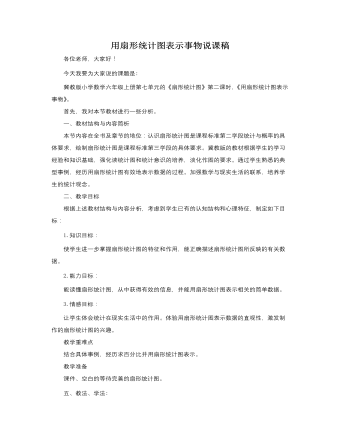
人教版新课标小学数学六年级上册用扇形统计图表示事物说课稿
(这一环节由学生熟知的典型事例入手,让学生感受到数学与生活的密切联系。把用数描述事物和用图描述事物整合在一起,使学生体会用图描述事物直观性的同时,建立数与形之间的联系,发展抽象思维。让学生通过自主探究、合作交流的学习方式来突破本节课的教学重点,鼓励学生说出自己的意见,并且通过多元化的评价激发学生的学习兴趣。)(三)及时练习课本103页练一练第一题让学生自主完成,填充空白统计图。提示学生标注名称和数据。(这一环节让学生体会数学在生活中的应用)(四)拓展延伸。观察两幅扇形统计图,回答问题。(这一环节给学生充分讨论交流的时间,让学生在讨论中互相补充,在讨论中不断完整自己的知识。让学生加深对扇形统计图的理解,理解单位一未知,无法根据百分比判断部分量的大小)(五)总结评价:
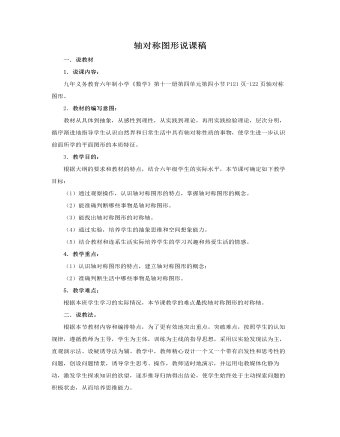
人教版新课标小学数学六年级上册轴对称图形说课稿
(二)归纳小结。设问:今天学了什么?什么叫轴对称图形?怎样判断轴对称图形?什么叫对称轴?怎样找出轴对称图形的对称轴?(新课后的总结能起到画龙点睛的作用,同时有利于帮助学生理清知识结构,形成完整认识。)现在能把两侧大小不同的蝴蝶图画成一模一样吗?(教师拿着新课引入时的不对称的蝴蝶图)(前后呼应,解答课前疑难,目的是检查学生活用知识的情况。)全课小结:这节课,我通过五个环节的教学设计,既遵循了概念教学的规律,又符合小学生的认知特点,指导学生操作、观察、引导概括,获取新知;同时注重培养学生的形象思维和抽象思维。在教学过程中让学生动口、动手、动眼、动脑为主的学习方法,使学生学有兴趣、学有所获。附板书设计:轴对称图形如果一条图形沿着一条直线对折,两侧的图形能够完全重合,这个图形就是轴对称图形。折痕所在的这条直线叫做对称轴。
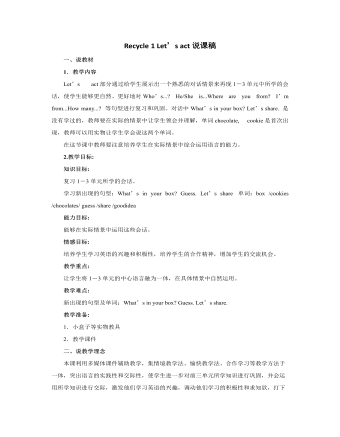
人教版新课标PEP小学英语三年级上册Recycle 1 Let’s act说课稿
小学生学习的主动性,大多取决于兴趣,他们充满好奇,对显而易见的实物和直观信息敏感性强、接受快。借助多媒体计算机CAI辅助教学,把所学内容更加直观地表现出来。4.游戏式复习热身,体现课堂教学开放性利用做游戏的形式进行旧知识的复习,既消除了上课初老师和学生之间的陌生感,又激发了学生学习兴趣,同时又对前面所学内容进行了巩固。5.综合运用“愉快教学”、“情境教学”、“合作学习”等多种教学方法,降低学习难度,活跃课堂气氛。6.展开活动式教学,设计各种形式为教学服务的活动,让学生在学中乐,在乐中学,不断强化知识的巩固记忆。7.设置评比台,及时评价小组及个人表现,鼓励学生积极参与学习活动。四、说教学流程1.拍手游戏热身2.师生问好,交流,对第一页内容复习3.引入第二页内容,学习新单词、句型4.趣味操练
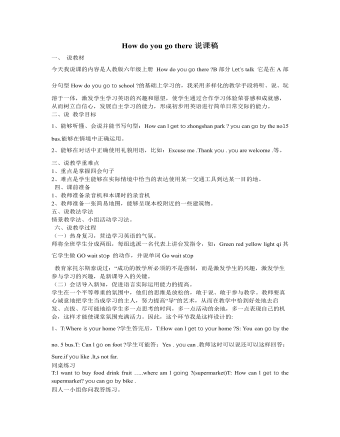
人教版新课标PEP小学英语六年级上册How do you go there说课稿
一、 说教材今天我说课的内容是人教版六年级上册 How do you go there ?B部分Let’s talk 它是在A部分句型How do you go to school ?的基础上学习的,我采用多样化的教学手段将听、说、玩溶于一体,激发学生学习英语的兴趣和愿望,使学生通过合作学习体验荣誉感和成就感,从而树立自信心,发展自主学习的能力,形成初步用英语进行简单日常交际的能力。二、说 教学目标1、能够听懂、会说并能书写句型:How can l get to zhongshan park ? you can go by the no15 bus.能够在情境中正确运用。2、能够在对话中正确使用礼貌用语,比如:Excuse me .Thank you . you are welcome .等。三、说教学重难点 1、重点是掌握四会句子2、难点是学生能够在实际情境中恰当的表达使用某一交通工具到达某一目的地。 四、课前准备 1、教师准备录音机和本课时的录音机2、教师准备一张简易地图,能够呈现本校附近的一些建筑物。
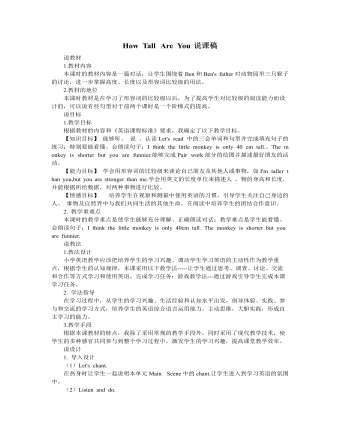
人教版新课标PEP小学英语六年级下册How Tall Are You说课稿
【设计思路】阅读最主要的目的是让学生看懂短文主要内容,通过上述判断题,可了解学生的掌握程度。(5)完成课文中的填空并校对。(6)学生听录音跟读,模仿录音中的语音语调。3.操练巩固请学生合作表演课文中的对话,课件出示情景和提示。这里也可进行分层次教学:有些学生擅长表演但语音语调在这节课上还没完全掌握,这里就可以请那些擅长表演的学生脱开课文表演,一部分学生可以与他人合作进行配音。【设计思路】 采用这个方式,可以照顾到程度不同的学生,参与面更广。本课时的阅读材料是动物间的比较,接下来我们要进行人物间的比较,让学生能更好地运用比较词和人称代词。这里可以采用游戏法和交际法。教师在屏幕上依次出现下列几组学生熟悉的人物:小丸子和蜡笔小新:王楠和张怡宁:贝克汉姆和欧文:樱木花道和流川枫。首先可以让学生猜一猜How old is he/she? How tall is he/she?Who is stronger/taller?Who is older/younger?等。
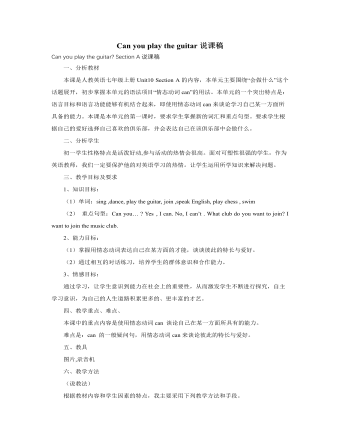
人教版新目标初中英语七年级上册Can you play the guitar说课稿
教材分析1、教材地位作用本单元围绕着学习情态动词can 的用法,来表达自己在某一方面所具有的能力。2、教学目标(知识目标、能力目标)(1)知识目标:复习情态动词can 的用法。(2)能力目标:通过学习can ,达到能灵活谈论自己的喜爱与特长,培养一种群体意识。3、重点和难点:(1)重点:情态动词can的一般问句的用法。(2)难点:利用上下文语境及略读技巧。二、教法:让学生默读课文(限时),让学生在短时内抓住课文的重点,划出关键词,从中亲自感受一下略读的技巧,然后老师加以指导。三、学情与学法针对学生在不理解情态动词can 的一般问句的情形下,反复阅读课文,从而加深对本单元前两页所学can用法的印象,从中真正感悟can的用法.
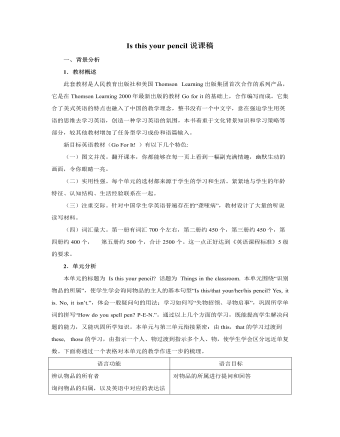
人教版新目标初中英语七年级上册Is this your pencil说课稿
教师准备利用录音使学生学习一些物品名词,并引导学生进行Pair work,学会询问“What’s this? It's a … . How do you spell watch? W-A-T-C-H.”;引导学生写“寻物启事”和“失物招领”,画图猜测物品,巩固所学内容,培养学生动脑、动手的能力及拾金不昧的精神和助人为乐、团结友爱的品德。学生准备学习一些物品名词,了解写寻物启事和失物招领的内容和格式。1. Warming up考虑到大多数学生以前学过一部分单词,可以以猜谜语竞赛的形式导出本课内容. 以pencil为例:Step1: 说出谜面, 可以用汉语解释.Our little JohnHas a wooden shirt on, And a long, sharp nose.He leaves his mark wherever he goes.接着教师画一件物品如:baseball 问学生:What’s this? 让学生使用句型 Is this a/an…?进行猜测。2. Group work学生分成四人或六人小组,将本单元的单词画出来加以猜测并评出最佳图画和最佳猜词者。3. Read ,circle and write1) Ask students to look back at page 10 . Have students read the list of the words . 2) Look at the Section B 3a . 3) Check the answers by having one student read his or her circled answers . Answers : computer game , ring , ID card , watch 4) Page 11 3b . this activity provide guided reading practice using the target language . Teacher told students that they are in the wrong order . when they are in the right order , they will make a clear message .
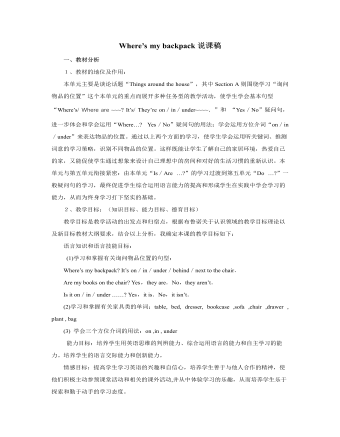
人教版新目标初中英语七年级上册Where’s my backpack说课稿
语言知识:Where is/are-----? Is it /Are they on/in/under-----? Yes, it is. / No, it isn’t.Yes, they are./ No, they aren’t.任务二:寻宝大行动活动目的:通过创设贴近生活的语言情景,学生自由选择所学的语言知识进行交流,培养学生综合运用语言的能力。活动过程:学生课前把自己最喜欢的一件东西收藏起来。以小组为单位,询问其他组员把宝物放在什么地方。规定时间内找到宝物最多者获胜。语言知识:Where is/are-----? Is it /Are they on/in/under-----? Yes, it is. / No, it isn’t.Yes, they are./ No, they aren’t.任务三:找差别活动目的:培养学生用英语思维的判辨能力,并对学生渗透德育教育:应该养成良好的生活习惯,保持房间干净整洁。活动过程:学生看两幅相似的图片,图片中有一些相同的物品,但所放的地点却不一样。以小组为单位,轮流询问有关物品所在的位置。学生记录下两幅图片中物品位置的不同,并在班上汇报自己小组得出的结果。
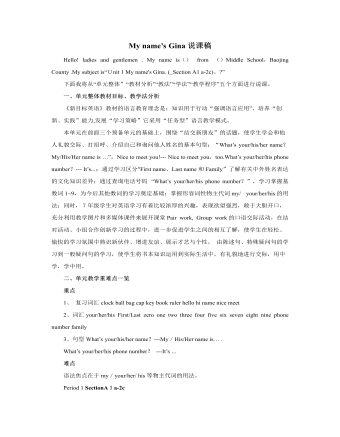
人教版新目标初中英语七年级上册My name’s Gina说课稿
1、利用插图或实物卡片让学生找出在预备篇中所学的单词,然后教师引导学习打招呼和介绍自己、询问他人姓名的基本句型。2、让学生听1a、1b对话,练习对话并模仿对话,结识班级的其他同学Step4 Practice师生互动(角色扮演) 让学生进行角色扮演1c、2c的对话,每两人一组,编对话,这个步骤主要是对1a-2b的内容进行巩固。Step5 听说活动(句型操练)1.播放2a部分的录音让学生听,引导学生通过听对话熟悉人名,完成2a,2b部分的教学任务。2.引导学生重复他们所听到的,模仿对话结识班级的其他同学,完成2c部分的教学任务。3.概括语法点Step6 知识拓展 引导学生阅读3a图中的名和姓,了解有关中外姓名的文化知识差异;从3a中给自己选一个姓、名,然后调查其他同学的姓、名,完成3b的任务。Step7 Conclusion复习本课重难点,巩固知识。Step8 Homework让学生在课后运用所学单词句型进行对话 练习。
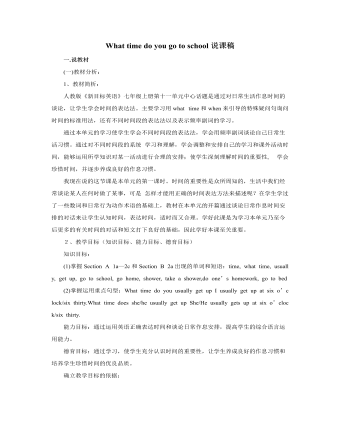
人教版新目标初中英语七年级上册What time do you go to school说课稿
人教版《新目标英语》七年级上册第十一单元中心话题是通过对日常生活作息时间的谈论,让学生学会时间的表达法。主要学习用what time和when来引导的特殊疑问句询问时间的标准用法,还有不同时间段的表达法以及表示频率副词的学习。通过本单元的学习使学生学会不同时间段的表达法,学会用频率副词谈论自己日常生活习惯。通过对不同时间段的系统 学习和理解,学会调整和安排自己的学习和课外活动时间,能够运用所学知识对某一活动进行合理的安排;使学生深刻理解时间的重要性, 学会珍惜时间,并逐步养成良好的作息习惯。我现在说的这节课是本单元的第一课时。时间的重要性是众所周知的,生活中我们经常谈论某人在何时做了某事,可是 怎样才能用正确的时间表达方法来描述呢?在学生学过了一些数词和日常行为动作术语的基础上,教材在本单元的开篇通过谈论日常作息时间安排的对话来让学生认知时间,表达时间,适时而又合理。

人教版高中历史必修3新文化运动与马克思主义的传播说课稿
一、说教材(一)教材分析本课所介绍的新文化运动,是继上一节所学的《西学东渐和维新变法思想》之后中国另一波影响巨大的思想解放潮流,旨在向西方学习、寻求强国御侮之道。在整个知识体系中,它既是资产阶级领导的旧民主主义革命的补课,又是无产阶级领导的新民主主义革命的序曲。它所带来的思想的空前解放,也就为马克思主义的传播创造了条件,为中共的成立奠定基础。这一课的学习能让学生清晰认识新文化运动和马克思主义在近代中国思想解放历程中的重要作用和巨大影响。与必修一和必修二政治经济史的结合也能让使学生强化历史联系。新课程标准对本课就做了明确的规定:1、概述新文化运动的主要内容,探讨其对近代中国思想解放的影响。2、简述马克思主义在中国传播的史实,认识马克思主义对中国历史发展的重大意义。根据课标要求,我制定了以下具体的三维目标。
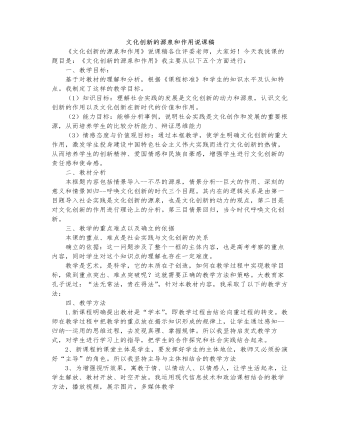
人教版高中政治必修3文化创新的源泉和作用说课稿
二、巨大的作用,深刻地意义材料展示:鲁迅在《狂人日记》中猛烈抨击“吃人”的封建礼教,力图通过自己的呐喊唤醒民众。高尔基早期的作品多描绘俄国沙皇制度下人民的痛苦和他们对美好生活的憧憬。20世纪初,俄国革命形势的发展使他讲文学的笔锋转向革命,创作了《母亲》等作品。合作探究:鲁迅和高尔基的作品在当时的中国和俄国分别起到了什么作用?列举喜爱的一些文学和艺术作品,说说创作者的意图是什么?引导学生自主阅读,培养自主学习能力,掌握分析归纳法和团结协作精神。学生回答之后师生共同总结:文化创新来源于社会实践,同也会对于社会实践产生新的影响,促进社会实践的变化,同时也繁荣了民族文化。所以文化创新的巨大作用一方面表现为推动社会实践的发展,另一方面表现为不断促进民族文化的繁荣。既然文化创新具有如此巨大的作用,那么作为新时代祖国的建设者为了繁荣民族文化,又该作些什么呢?进入本课第三目和教学的第三个环节。[情景回归参与生活]
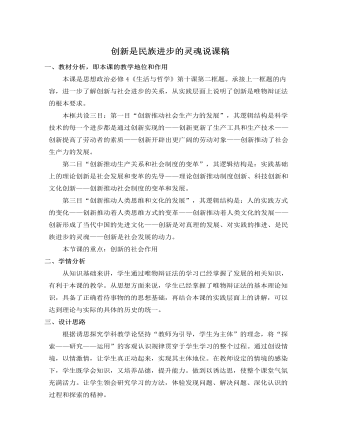
人教版高中政治必修4创新是民族进步的灵魂说课稿(二)
“蛟龙号”深潜器的总设计师——中船重工第七〇二研究所的徐芑南,他先后三次被评为江苏省和无锡市劳模,曾被评为上海市科技功臣,有十几个国家、部、省、市级科技进步奖项与他的名字相联。在徐芑南眼中,这些都只是“副产品”,为国家设计出最需要的潜水器,让中国具备从“浅蓝”走向“深蓝”的能力,这才是他最大的愿望。每当说到大洋的海底世界,徐芑南的语速快了起来:“海底有好多资源,等着我们去发现、去利用,我们不能落在别人的后面!”海底有石油,海底有许多未知的生物,还有锰结核、钴结壳、热液硫化物……“蛟龙号”的立项目的就是为了探明神秘的深海世界,造福人类。探究活动二:结合材料和教材,阐述创新与人类思维方式变革的关系。(设计意图)通过学生们感兴趣的材料,对本课的教学难点加以突破。

新人教版高中英语必修3Unit 1 Festivals and celebrations-Discovering Useful Structure教学设计
4.That was an experience that frightened everyone. →That was _____________________. 答案:1. taking 2. being discussed 3. in the reading room 4. a frightening experienceStep 6 The meaning and function of V-ing as the predicative动词-ing形式作表语,它通常位于系动词后面,用以说明主语“是什么”或“怎么样”一种表示主语的特质、特征和状态, 其作用相当于形容词; 另一种具体说明主语的内容, 即主语等同于表语, 两者可互换。The music they are playing sounds so exciting. 他们演奏的音乐听起来令人激动。The result is disappointing. 结果令人失望。Our job is playing all kinds of music. 我们的工作就是演奏各种音乐。Seeing is believing. 眼见为实。Step 7 Practice1. It is ________(amaze) that the boy is able to solve the problem so quickly.2. Buying a car is simply _______(waste) money. 3. Please stop making the noise—it’s getting ________(annoy). 4. complete the passage with the appropriate -ing form.La Tomatina is a festival that takes place in the Spanish town Bunol every August. I think many food festivals are __________ because people are just eating. however, this festival is _________ because people don't actually eat the tomatoes. Instead, they throw them at each other! the number of people ________ part in this tomato fight, can reach up to 20,000, and it is a very __________ fight that lasts for a whole hour. The _______ thing is how clean Bunol is after the tomatoes are washed away after the fight. this is because the juice form tomatoes is really good for making surfaces clean!答案:1. amazing 2. wasting 3. annoying4. boring interesting taking exciting amazing

新人教版高中英语必修3Unit 1 Festivals and Celebrations-Reading and Thinking教学设计
The topic of this part is “Discover the reasons for festivals and celebrations.The Listening & Speaking & Talking part aims at talking about the experiences and feelings or emotions about the festivals and celebrations. This section aims at detecting the reason why the people celebrate the festivals, the time, the places, the types and the way of celebrations. It also explains why some traditions in the old celebrations are disappearing, like the firecrackers in the big cities and some new things are appearing like the prosperity of business or commerce. 1. Students can talk about what festivals they know and the reasons and the way of celebrating them.2. Students should learn the reading skills such as the headline and get the topic sentences, the structures of articles.3. Students can understand the past, the present situation of some festival around the world and why there are some changes about them. 4. Students can have the international awareness about the festivals.1. Students should learn the reading skills such as the headline and get the topic sentences, the structures of articles.2. Students can understand the past, the present situation of some festival around the world and why there are some changes about them.Step 1 Lead in---Small talkWhat festival do you like best ? Why ?I like the Spring Festivals because I can set off the fireworks, receive the lucky money and enjoy the Gala with my families.Step 2 Before reading---Pair workWhy do people celebrate different festivals ?The Spring Festivals is to celebrate the end of winter and the coming of spring and new life.The Mid-autumn Day is to celebrate the harvest and admire the moon.

新人教版高中英语必修3Unit 1 Festivals and Celebrations-Listening &Speaking&Talking教学设计
The theme of this section is “Talk about festival activities and festival experiences”.Festival and holiday is a relaxing and interesting topic for students. This part talks about the topic from the daily life of students’. In the part A ---Listening and Speaking, there are three conversations among different speakers from three countries(Japan, Rio and China), where the speakers are participating in or going to participate in the festivals and celebrations. So listening for the relationship among them is a fundamental task. Actually, with the globalization and more international communication, it is normal for Chinese or foreigners to witness different festivals and celebrations in or out of China. In the Conversation 1, a foreign reporter is interviewing a Japanese young girl who just had participated in the ceremony of the Coming-of-Age Day on the street and asking her feeling about the ceremony and the afterwards activities. Conversation 2, Chinese girl Li Mei is witnessing the Rio Carnival for the first time, and her friend Carla gives her some advice on the costumes which enables her to match with the carnival to have a good time. Conversation 3, a Chinese guide is showing a group of foreign visitors around the Lantern Festival and introducing the customs of the festival to them. The three conversations have a strong vitality and insert the festival and cultural elements from different countries. So perceiving the festivals and cultures from different countries is the second task. At the same time, the scripts also insert the targeted grammar --- v-ing as attributive and predicative, which students can perceive and experience in a real context and make a road for the further study. That is the third task. In the Part B--- Listening and Talking, the theme is “Talk about festival experience”, which is the common topic in our daily conversations. During the conversation, Song Lin, a Chinese student, asked Canadian friend Max about how to spend Christmas. In the conversation, Song Lin talked about experience and the feelings during the Chinese Spring Festival, during which there are not only some enjoyable things but some unpleasant things. After the listening, perhaps students find there are some similarities between Christmas and the Chinese Spring Festival as there are some differences in the origins and celebrations. For example, people always visit friends and relatives, decorate their houses, have a big dinner together, chat and give presents to each other.

新人教版高中英语必修3Unit 1 Festivals and Celebrations-Reading for writing教学设计二
Step 3 Analyzing article structureActivity 31. Teachers raise questions to guide students to analyze the chapter structure of this diary and think about how to describe the festival experience. (1)What should be included in the opening/body/closing paragraph(s)?(2)How did the writer arrange his/her ideas?(3)What kind of interesting details did the writer describe?(4)How did the writer describe his/her feelings/emotions during the event?2. Students read and compare the three sentence patterns in activity 2. Try to rewrite the first paragraph of the diary with these three sentence patterns. After that, students exchange corrections with their partners. Such as:●This was my first time spending three days experiencing the Naadam Festival in China’s Inner Mongolia Autonomous Region and it was an enjoyable and exciting experience. ●I'll never forget my experience at the Naadam Festival because it was my first time to watch the exciting Mongolian games of horse racing, wrestling, and archery so closely. ●I'll always remember my first experience at the Naadam Festival in China’s Inner Mongolia Autonomous Region because it was so amazing to spend three days witnessing a grand Mongolian ceremony. Step 4 Accumulation of statementsActivity 41. Ask the students to read the diary again. Look for sentences that express feelings and emotions, especially those with the -ing form and the past participle. Such as:● …horse racing, wrestling, and archery, which are all so exciting to watch. ● some amazing performances● I was surprised to see…● I was a little worried about. . . ● feeling really tiredOther emotional statements:●I absolutely enjoyed the archery, too, but the horse races were my favourite part. ●I'm finally back home now, feeling really tired, but celebrating Naadam with my friend was totally worth it. ●He invited me back for the winter to stay in a traditional Mongolian tent and cat hot pot. I can’t wait!2. In addition to the use of the -ing form and the past participle, the teacher should guide the students in the appreciation of these statements, ask them to memorize them, and encourage them to use them reasonably in writing practice.